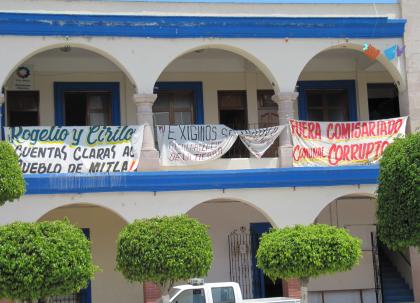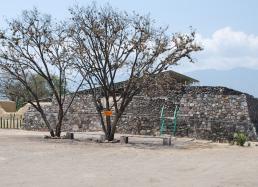1: A Shift in Plans: The Ugly, the Bad, and the Good
When we arrived in Mitla about a month back, we'd already been told there were ongoing social conflicts, but we didn't know their depth or intractability. Mitla is governed by two sets of authorities, one is municipal and the other is in charge of communal lands. The head of the municipal government carries the title, Presidente, but in regard to communal land, his authority is limited. The Fortress, where we hoped to investigate, sits on communal lands, a few kilometers from the center of town.
During the three previous years that we excavated at the Mitla Fortress, we were always supported entirely by the municipal authorities and also by the great majority of people in the community. But our relations with the communal lands officials tended to be more guarded and less predictable, although we always did manage to get their permission, with the assistance of the National Institute of Anthropology and History (INAH), the federal agency that awards permits for all archaeological exploration in the country.
Our relations with Mitla’s communal land officials were particularly challenging in 2011 (our previous field season), when a new group of authorities were elected to be in charge of communal lands (these positions rotate every three years).
When we arrived this March, there was a rather ugly situation. The communal lands authorities had been locked out of their offices on the town square by the rest of the community. Banners in the square denounced their leaders by name. The people of Mitla elected new individuals to enact day-to-day local business concerning communal lands. But, despite being thrown out of their offices, the original authorities still held their official titles in the records of the national government.
We entered the scene needing (as always) permission from both sets of local authorities. As usual, we received permission and a warm welcome from the municipal authorities. Before Easter, in conjunction with INAH, we were able to negotiate verbal permission with the communal lands officials, and we began a few days of research at the Fortress, where in no time we began to peel back a prehispanic house foundation.
But alas, with Easter fast approaching, no written agreement could be reached between these officials, INAH, and ourselves. To make matters more challenging, the communal lands authorities kept adding new conditions during our discussions.
Unfortunately, Easter was rapidly followed by the Society for American Archaeology meetings in Hawaii, in which many representatives of INAH, including many people tied to the Oaxaca office, had long planned to attend, presenting research papers, etc. With these meetings and the resultant absences on the horizon, some of the communal lands authorities arrived at the Fortress during our investigations and said that we no longer had their permission, because a written agreement had not been reached/signed.
So, while many of the key archaeologists were away, we (and others) tried various tacks to regain permission from this group to investigate at the Fortress, but no progress was made. Several local, peripheral events that didn't involve us further flared animosities and tensions.
Early on, I realized that we were at a serious impasse. We were just pawns in a debate in which the communal lands folks, angry about their eviction from their offices and intent on creating issues for a rapidly approaching local election campaign, were not going to yield.
At the same time, the legal offices at INAH felt, for good and understandable reasons, that we needed the permission of these same authorities, since they still held their official titles in the eyes of the Federal Government in Mexico City. So we waited, and the bad news is that we not only lost precious time, but we will not be working at the Fortress this year.
Once we realized that this impasse would not end where we hoped it would, we began to raise the possibility of alternative options that met our long-term research aims with INAH representatives. At the same time, any alternative would also have to be a project already approved and on the docket by the Council of Archaeologists, who governs permits for INAH.
Several weeks ago, we began excavations (in collaboration with INAH) at the large site of Lambityeco (about 20 minutes drive from Mitla). The occupations at Lambityeco are roughly contemporaneous with the principal occupations at El Palmillo and the Mitla Fortress. Lambityeco already has a small archaeological zone (open to visitors) that includes an elite residence with a bevy of elaborate excavated tombs.
Fortuitously, INAH had just purchased more of the site from local owners, not only to protect it, but also with the idea of expanding the archaeological zone. They generously have given us permission to excavate a prehispanic (Late Classic period, ca. A.D. 500-850) elite residence on this recently purchased land, which, depending on our findings, may ultimately be conserved, reconstructed, and open for tourism.
If the collaboration this year goes well, we may continue at this elite residential complex (or elsewhere at Lambityeco) in subsequent seasons. The area where we're now excavating is a mound or raised platform, adjacent to the tallest platform (probably a temple) at the site and has a chance to be an excellent comparable example to the palaces that we excavated several years ago at El Palmillo (some of you also may have seen an article that we wrote about the Mitla Fortress, where we discussed the image of a lord wielding a femur, which was recovered many years back during excavations at Lambityeco).
And the data that our 2013 investigation should provide will enable us to continue to study the Late Classic-period reorganization and transitions in the Valley of Oaxaca from a new perspective, one that allows us to build on decades of earlier archaeological studies while also having the chance to collaborate more directly with Mexican colleagues. These opportunities are much more than good, they're exciting and they open a new chapter for us, which we look forward to sharing with you over the next weeks, months, and possibly beyond.
More soon,
Gary







